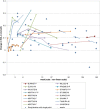The effect of quitting smoking on HDL-cholesterol - a review based on within-subject changes
- PMID: 24252691
- PMCID: PMC4177613
- DOI: 10.1186/2050-7771-1-26
The effect of quitting smoking on HDL-cholesterol - a review based on within-subject changes
Abstract
A higher concentration of high density lipoprotein cholesterol (HDL-C) in ex-smokers than smokers has consistently been observed. Better evidence of quitting effects comes from within-subject changes. We extend an earlier meta-analysis to quantify the reduction, and investigate variation by time quit and other factors. We conducted Medline and Cochrane searches for studies measuring HDL-C in subjects while still smoking and later having quit. Using unweighted and inverse-variance weighted regression analysis, we related changes (in mmol/l) to intra-measurement period, and estimated time quit, and to study type, location and start year, age, sex, product smoked, validation of quitting, baseline HDL-C, baseline and change in weight/BMI, and any study constraints on diet or exercise. Forty-five studies were identified (17 Europe, 16 North America, 11 Asia, 1 Australia). Thirteen were observational, giving changes over at least 12 months, with most involving >1000 subjects. Others were smoking cessation trials, 12 randomized and 20 non-randomized. These were often small (18 of <100 subjects) and short (14 of <10 weeks, the longest a year). Thirty studies provided results for only one time interval. From 94 estimates of HDL-C change, the unweighted mean was 0.107 (95% CI 0.085-0.128). The weighted mean 0.060 (0.044 to 0.075) was lower, due to smaller estimates in longer term studies. Weighted means varied by time quit (0.083, 0.112, 0.111, 0.072, 0.058 and 0.040 for <3, 3 to <6, 6 to <13, 13 to <27, 27 to <52 and 52+ weeks, p=0.006). After adjustment for time quit, estimates varied by study constraint on diet/exercise (p=0.003), being higher in studies requiring subjects to maintain their pre-quitting habits, but no other clear differences were seen, with significant (p<0.05) increases following quitting being evident in all subgroups studied, except where data were very limited. For both continuing and never smokers, the data are (except for two large studies atypically showing significant HDL-C declines in both groups, and a smaller decline in quitters) consistent with no change, and contrast markedly with the data for quitters. We conclude that quitting smoking increases HDL-C, and that this increase occurs rapidly after quitting, with no clear pattern of change thereafter.
Figures

References
-
- US Surgeon General. The health benefits of smoking cessation. A report of the Surgeon General: US Department of Health and Human Services, Public Health Service, Centers for Disease Control, Center for Chronic Disease Prevention and Health Promotion. Rockville, Maryland: Office on Smoking and Health; 1990. DHHS Publication No. (CDC) 90–8416. http://www.surgeongeneral.gov/library/reports/index.html.
-
- US Surgeon General. The health consequences of smoking. A report of the Surgeon General. Atlanta, Georgia: US Department of Health and Human Services, Centers for Disease Control and Prevention, National Center for Chronic Disease Prevention and Health Promotion, Office on Smoking and Health; 2004. http://www.surgeongeneral.gov/library/reports/index.html.
LinkOut - more resources
Full Text Sources
Other Literature Sources
Medical

